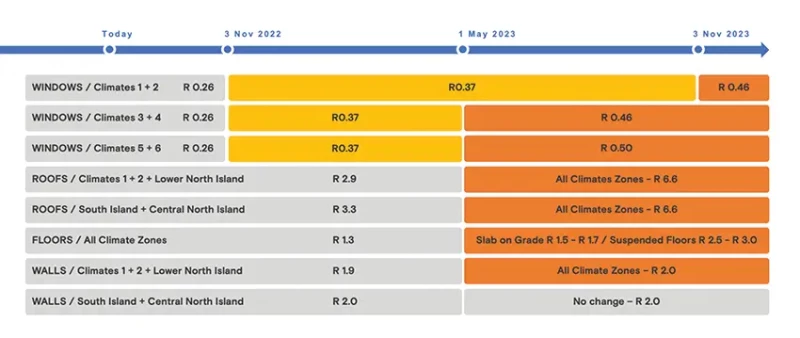With recent changes to the H1 Energy Efficiency Building Code, there are several positive outcomes that will benefit homeowners in the long run. In this article, we discuss the advantages of these changes and how, from a central heating perspective, they might affect the house design.
One of the significant benefits of the H1 energy efficiency building code changes is the increased insulation requirements for new homes. This H1 requirement ensures that homes have higher insulation levels, resulting in increased energy efficiency and reduced energy bills. This change is particularly beneficial for those who enjoy the luxurious comfort of a central heating system, as it reduces heat loss through walls, roofs, and floors resulting in a more responsive system with lower running costs.
With increased insulation, and a lower heat loss through the walls/floor, the heat source for the central heating system can work more efficiently and will require less energy to maintain a comfortable temperature inside the home. With a lower heat loss, the boiler or heat pump can be set at a lower temperature compared with previous insulation levels. This will result in a higher appliance efficiency.
In some situations, these increased insulation levels will allow a smaller or different heat source option to be used to provide the home's heating. This provides the homeowner with more choices that fit within their budget and in most cases a lower installed cost compared with the same home insulated to the previous insulation standards. The reduced install and running costs that will occur as a result of the home's higher insulation levels will provide a significant saving to the homeowner over the life of the home, keeping in mind that unlike other systems, a water-based hydronic system will have a longer life expectancy ensuring these running cost savings are achieved for many years.
When it comes to incorporating hydronic underfloor heating into a building project, it's important to consider the H1 insulation requirements for the heated floor. In the past, the standard insulation requirement for heated floors was R1.9, however, this standard has changed, and the new minimum insulation requirement for heated floors is now between R2.5 and R3 depending on the region's climate zone where the project is located.

This increased insulation requirement is in response to a growing awareness of the importance of energy efficiency in building design. With better insulation, the underfloor system can operate more efficiently, resulting in lower energy costs and a reduced carbon footprint. Additionally, better insulation helps to prevent heat loss, which is especially important for heated floors, as they operate at a lower temperature than traditional heating systems. This will further help to increase the efficiency and reduce the running cost of an underfloor system. We have calculated that the increase from the previous R1.9 to R3.0 will result in a 33% reduction in the amount of heat that is lost from an underfloor heating system (system losses reduced from 15% to 10%).
To meet the new H1 insulation requirement of R2.5-R3, changes may need to be made to the slab design. This could include the addition of edge insulation, increasing the slab thickness, or selecting a more effective insulation material. The cost of these changes will depend on the specific project and the size of the area being heated, but it's important to factor in these costs when planning a project that includes underfloor heating.
Overall, while the increased insulation requirements may add some additional complexity and cost to a project, the benefits of a more comfortable, healthy, efficient, and environmentally friendly heating system make it a worthwhile investment for builders and homeowners. As these additions will allow the central heating system to be more efficient and incur lower running costs, the initial investment required for these upgrades is expected to yield multiple returns throughout the system's lifespan.
When does it come into effect?
Minimum Construction R-Values by Element and 5th Edition Climate Zone.

The changes to the H1 energy efficiency building code are a positive step towards making homes in New Zealand more energy-efficient and comfortable. At Central Heating New Zealand, we are excited about these changes and welcome the opportunity to help homeowners achieve greater energy efficiency and reduced heating cost, while still providing them with the same high level of comfort that they have come to know from our custom-designed central heating systems. With higher insulation levels, better glazing, and efficient heating systems, homeowners can look forward to a more comfortable and energy-efficient home.






